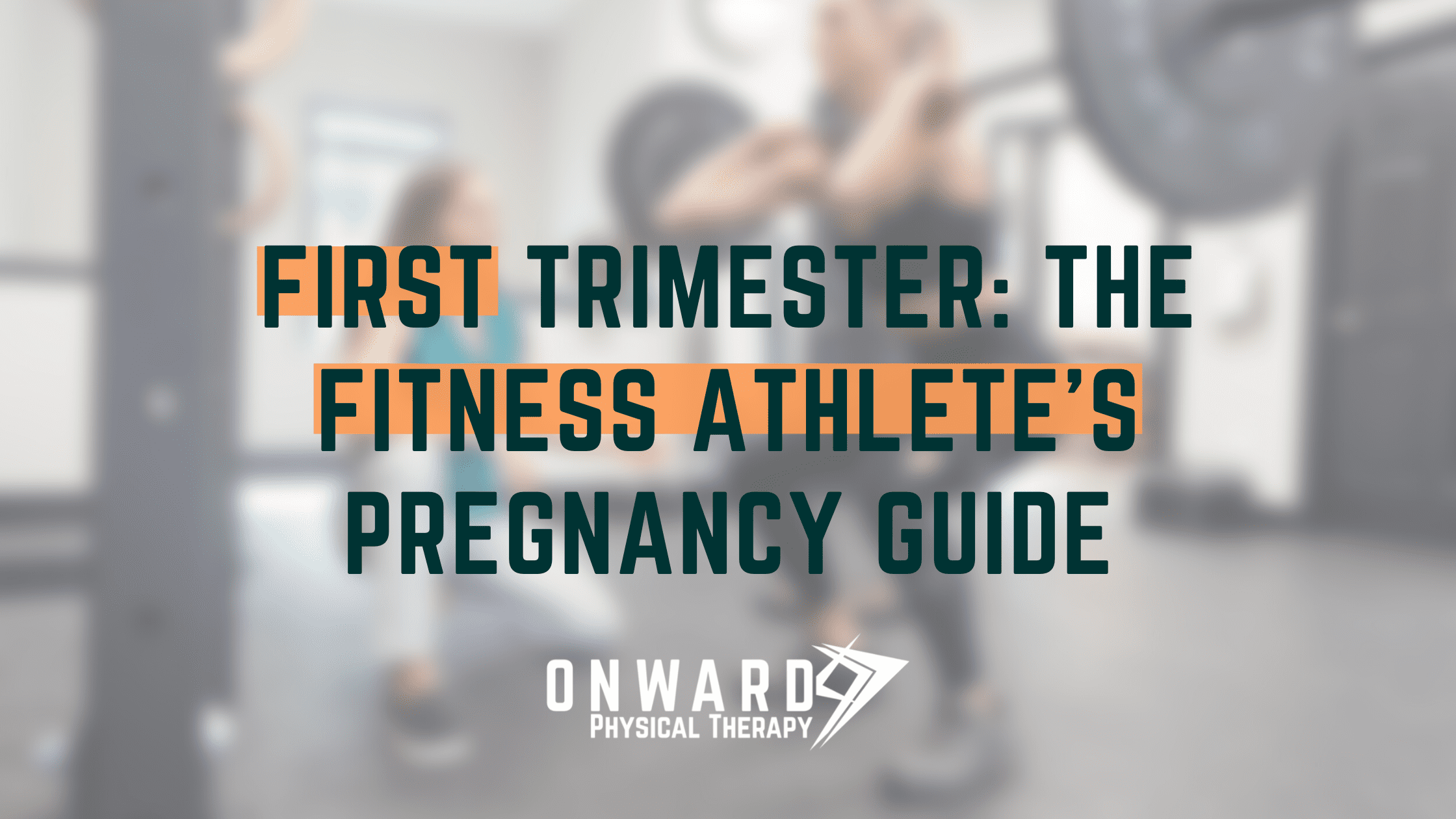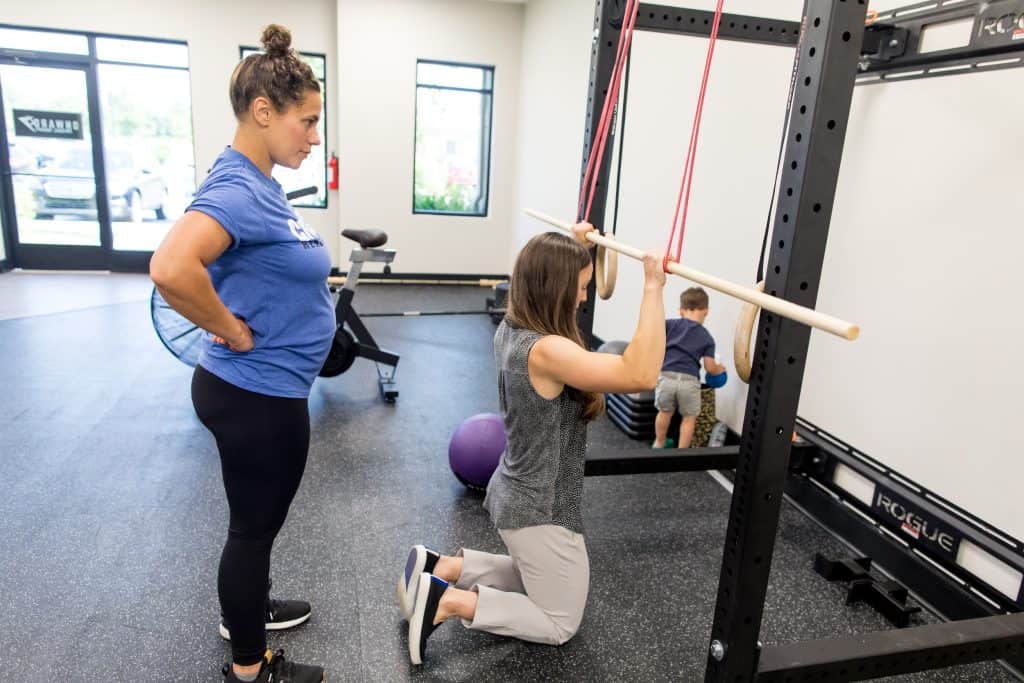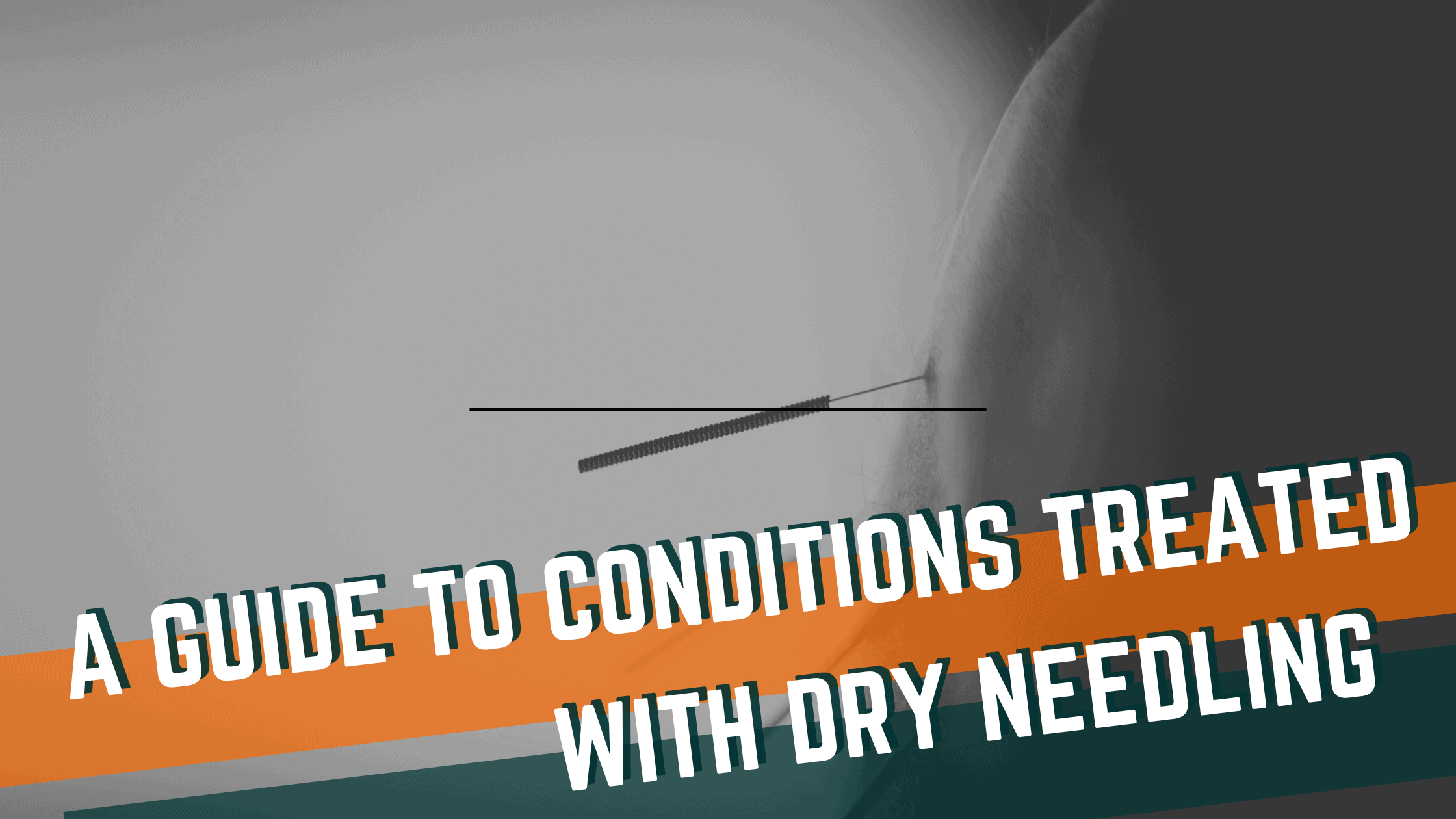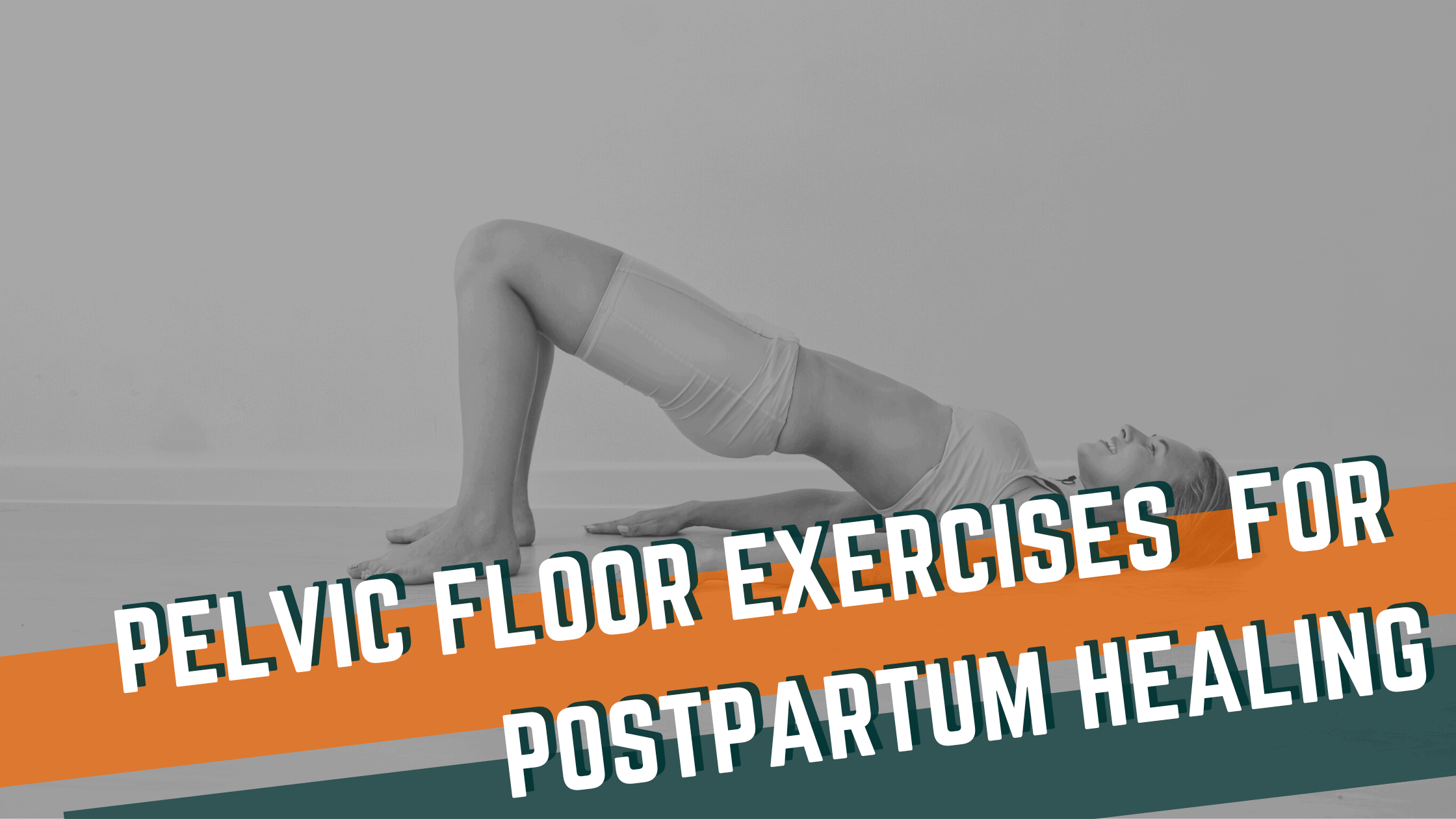
Whether this is your first pregnancy or you’re a “seasoned pro,” you probably have questions about how to navigate your fitness journey with now being pregnant.
This 3-part blog series is for you if you:
- Identify as a fitness athlete: CrossFit or Burn Bootcamp; F45 or powerlifting; weightlifting or HIIT (or if you’d like to start one of these!)
- Want guidance on navigating your athleticism throughout pregnancy
- Need to know what to expect and when to modify exercise
- Are pregnant for the first time OR have been pregnant many times before
- Read this earlier blog on CrossFitting during pregnancy & are looking for more details
First Trimester Overview

During the first 12 weeks of pregnancy, the fetus grows from the size of a poppy seed to a lemon! While it may not seem like that’s too taxing on the body, it’s actually quite the opposite.
There are SO many changes that occur in your body during the first trimester, even if you don’t necessarily “look” pregnant. So let’s dive in, shall we?
Pregnancy Changes to Your Heart & Blood

The volume of blood in your body actually increases steadily throughout your entire pregnancy, and this starts during the first trimester. Because there is more blood in your body, your heart is working harder to pump it. You may notice that your resting heart rate (the number of times your heart beats per minute) actually increases by 10 to 20 beats per minute!
This means that when you exercise, you will notice your heart rate going higher and getting there more quickly. Many athletes often feel “out of shape” when they notice this change, but you’re not at all out of shape! You are simply experiencing these normal changes from pregnancy.
Some individuals are uncomfortable lying on their backs or may experience dizziness (called “supine hypotensive syndrome”). This usually does not occur until the 2nd or 3rd trimester, due to the size of the uterus being small relative to your blood vessels.
There have been zero studies linking exercise on your back to pregnancy or birth complications 1,2. Rule of thumb: prop yourself up on an inclined bench or against a medicine ball for these exercises, particularly if you have symptoms.
What to do:
- Warm-up prior to exercise
- Take rest breaks to catch your breath or lower your heart rate as needed
Lung & Respiratory Changes from Pregnancy

Welcome to the first trimester, where you now need approximately 30% more oxygen than you did before you were pregnant! As you progress through pregnancy, you’ll notice taking deeper breaths becomes more challenging. Why? Your growing uterus begins to press UP on you ribs, diaphragm, and lungs. There’s simply less room for your lungs to expand, despite your rib cage actually expanding outwards from these changes.
What to do:
- Practice diaphragmatic breathing or “belly breathing” to optimize your oxygen consumption needs
- Take breaks during exercise to catch your breath
Muscular Changes
Many changes occur to your musculoskeletal system during pregnancy.

The Bump
Initially, during the first trimester, you may not notice any changes in your muscles, particularly if this is your FIRST pregnancy. However, for those of you who have been pregnant before, you’ll likely notice your abdominal muscles lengthening: aka the “baby bump.” This obviously increases throughout pregnancy and shifts our center of gravity forward. This is why your balance is “off” when doing snatches, cleans, or deadlifts. This is also why you may feel not as strong when doing exercises like toes to bar or GHD sit-ups.
Concerned about doming or coning during exercise? Or diastasis recti during either pregnancy or postpartum? Read more here.
Pelvic Floor
At the base of your pelvis, there is a group of muscles collectively called “the pelvic floor.” These are the muscles around your vagina, rectum, and urethra that allow for these holes to open or close. There are more muscles in the pelvic floor that provide support to the organs above: the bladder, colon, and uterus (which is increasing in weight & size).
The pelvic floor muscles go through a LOT of changes through pregnancy alone (despite how you wind up delivering). It’s best to respect the pelvic floor during this time and if you’re having issues, work with a pelvic floor physical therapist as soon as possible.
Reasons to modify exercise & see a pelvic PT:
- Leaking with exercises like running, jumping, deadlifting
- Feelings of bulging or heaviness at the vagina or rectum
- Pain in or around the pelvis
And if you’re wondering, here’s 21 signs you need a pelvic floor physical therapist.
Weight Changes
You can expect to gain weight during pregnancy. You’ll likely wind up gaining between 25 to 40 pounds by the end of pregnancy. On average, 5 of those pounds are gained during the first trimester. For most, this is not enough weight (yet) to change your capacity to hang from the rig for pull-ups or toes-to-bar. However, if you notice your grip strength is challenged by hanging, swap to a feet-supported position. More guidance on pull-ups during pregnancy here.
Gaining weight during pregnancy is a challenge to many fitness athletes. Seeing the scale increase combined with feeling bigger, more swollen, out of breath, and less-recovered can result in mental health & body-image struggles. If this is you, you are not alone. Many women work with mental health professions to reduce dissatisfaction &/or improve body image. Taking early steps now will help even more during postpartum.
The Secret
To tell friends, family, or coworkers…. Or not to…

While societal norms are to wait to announce the pregnancy until after 12 weeks, many individuals disclose pregnancy news sooner or later.
Maybe you’ve been through IVF treatments & your close friends/family have been supporting you through it. Or perhaps you’ve had miscarriage(s), & decide to tell those close to you as soon as you find out for additional support. You might decide you’d rather keep the news between you & your partner until 20 weeks for professional reasons. Whatever the timeline or the reasons, you have the right to choose.
We recommend that when you are ready, inform your coach so she or he can best support you.
Pregnancy Exercise Recommendations
You’ve made the decision to exercise during your first trimester of pregnancy? Congratulations! This is great news. Exercise has been shown over & over again in the research to be extremely beneficial to physical and mental well-being for mom. Exercise is increasingly being shown to have benefits for the fetus, as well!
Recommendations for Pregnancy & Exercise 3:
- Accumulate 150 minutes of moderate physical activity
- Spread that across at least 3 days during the week
- Vary exercise between aerobic AND strength training
Step 1:
The best place to start is here: Take 2 minutes to quickly fill out the “Get Active Questionnaire for Pregnancy.” If you answer “yes” to any of these questions, speak with your doctor before starting exercise. (And if you answer “yes,” it is also recommended to have a Physical Therapist specifically trained in working with pregnant athletes to help guide you.)
Step 2:
Download this simple FREE guide: “Traffic Light Guide to Exercise During Pregnancy”
Safety Precautions to Keep in Mind
There are some general prenatal exercise safety precautions to keep in mind:
- Avoid:
- Contact sports
- Activities with high risk of falling (ring muscle ups, handstands, etc., particularly if you are new to these movements)
- Scuba diving
- Maintain proper hydration and nutrition
- No additional calories are needed during first trimester. However, if you are eating less due to nausea, be sure to adjust exercise regime accordingly
- Caution if traveling to exercise in high altitude
- If considering competition, discuss with your doctor, physical therapist, and coach
While no additional calories are needed during first trimester, be sure to monitor volume and intensity of exercise particularly if nausea is preventing caloric intake

About the Author
Dr. Alexis Morgan, PT, DPT is a physical therapist specially trained in internal pelvic floor assessment & treatment. She combines her extensive knowledge of exercise physiology alongside women’s health issues to optimize life & performance for her clients.
Dr. Alexis teaches other providers across the US and Canada how to better treat female athletes with the Institute of Clinical Excellence. Work with Dr. Alexis either in person or via telehealth by booking a session today.
Recent Articles
Achilles Tendonitis: Diagnosis & Treatment

Hip Pain in Runners

A Guide to Conditions Treated with Dry Needling

Reconnect to the CORE Postpartum: Pelvic Floor Exercises for Postpartum Healing

Preventing Back Pain in CrossFit: Key Considerations for Training Safely


